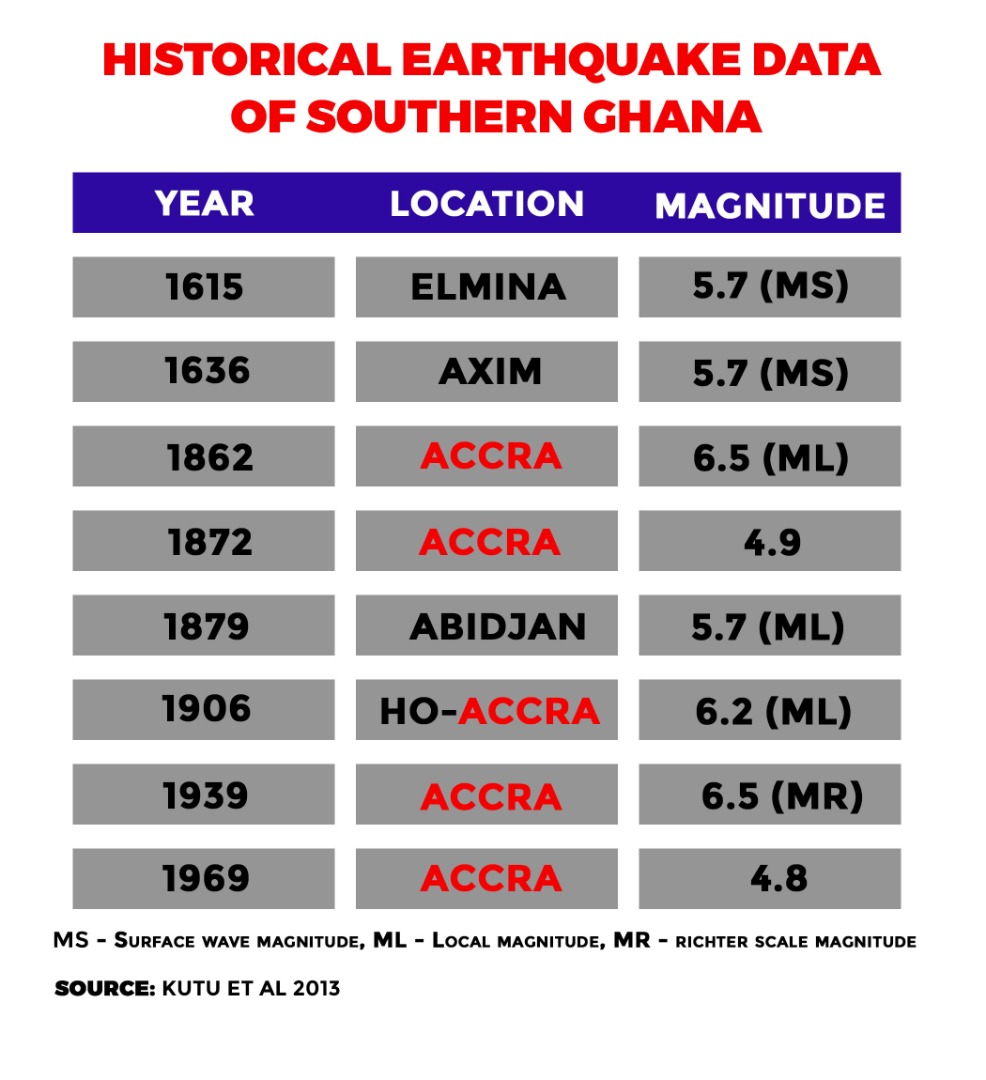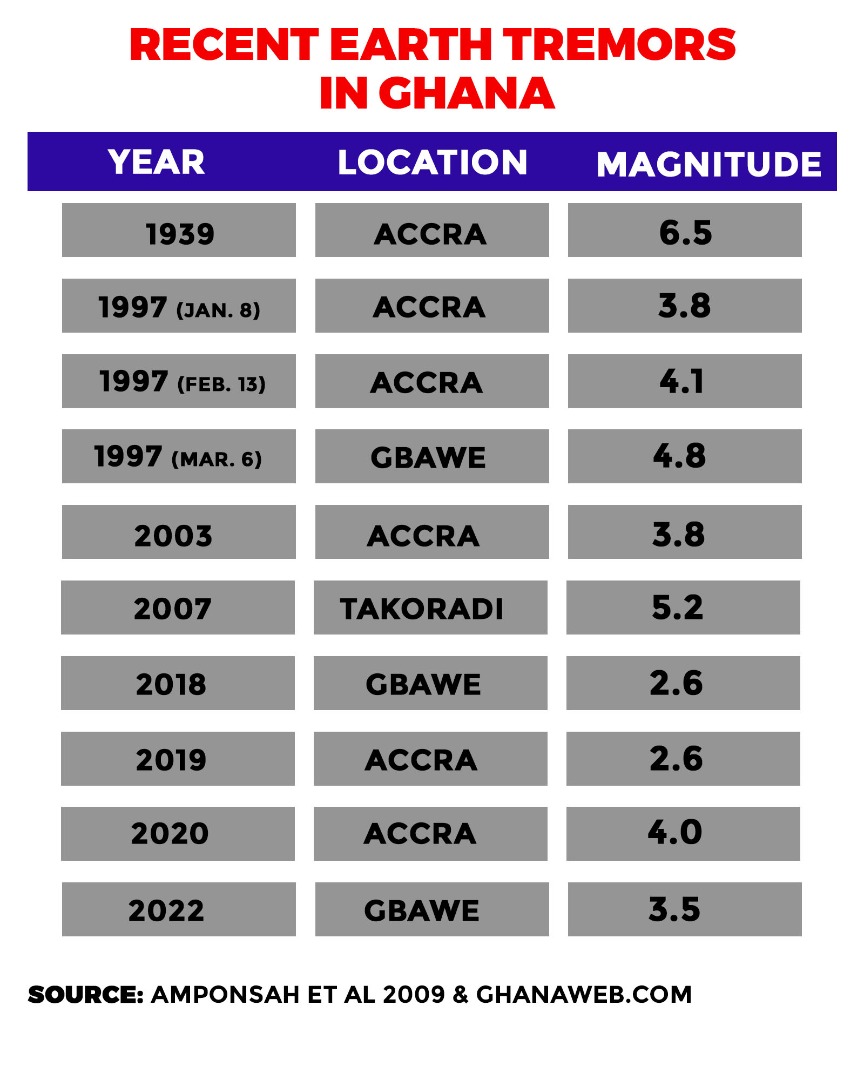Is Ghana ready for an imminent earthquake?
It was barely fifteen minutes to midday on December 12, 2022, and some of my colleagues at work were preparing to set off for lunch. I received a short note from my supervisor to carry out a task which meant that I would have to extend my stay at the office as they leave.
I uncrossed my legs and drew my seat closer to the desk for maximum concentration. Good time to continue sipping at my orange juice as well. Four minutes later, I sensed a quick vibration similar to a massive ball of ‘stone’ rolling on the earth, beneath my feet.
“Did you feel any vibration right now?” I quizzed Eric, whose desk is about half a meter from mine. He replied, “yeah, is that an earthquake?”
Earthquakes are generally defined as sudden, rapid shaking of the ground caused by the rapture and shifting of rock beneath the earth’s surface. It is a natural disaster.
This shaking can cause damage to buildings and bridges; disrupt gas, electric, and phone service; and sometimes trigger other natural disasters including landslides, avalanches, flash floods, fires, and huge, destructive ocean waves (tsunamis) among others.
The most powerful and largest quake in the world was the 9.5-magnitude Valdivia Earthquake that struck Chile in 1960. This quake triggered a tsunami which together killed an estimated 5,700 people.
It is further reported that China was hit by the deadliest quake in world history as far back as January 23, 1556, A.D. The earthquake rocked the province of Shaanxi and its neighbouring province killing an estimated 830,000 people.
Ghana’s cake of earthquake events
For nearly forty centuries, humans have been experiencing earthquakes across the globe but the anglophone west African country Ghana has been recording quakes in the southern part for the past four centuries.
The biggest earthquakes in Ghana’s history both struck the capital Accra in 1862, 1939 and were both of 6.5 magnitudes.
Ghana’s second-largest earthquake was a 6.2-magnitude Ho-Accra quake that occurred in 1906.
The southwestern part of Ghana remains the first portion of the country to have tasted the natural disaster of earthquake with the first two events both recording 5.7 magnitude. Those quakes occurred in Elmina (1615) and Axim (1636).

The 1939 Accra earthquake of 6.5 magnitude is reported to have killed 17 people with 133 injured.
After fifty-eight years of seismic quiescence, Ghana returned on the pathway of earth tremors and the year 1997 in Accra was significant.
Per the data available, it remains the only year in which the country recorded three earth tremors in a span of three months.
A 3.8-magnitude tremor struck Accra on January 8, 1997; the second of magnitude 4.1 on February 13, 1997, and the third on March 6, 1997, of magnitude 4.8.
The year 2003, 2006 and 2007 were also earmarked by seismic events with magnitudes of 3.8, 3.7, and 5.2 respectively.
With the exception of the year 2021, Ghana has been recording at least one annual earth tremor since 2018.

The most recent tremor in 2022, shook Accra at 11:49 am, 11:53 am and 11:58 am with the epicentre located between Wiaboman and Bojo beach about 575m into the sea.
According to Ghana Geological Survey Authority, the foreshock, main shock and aftershock of December 12, 2022, earth tremor were measured to have magnitudes of 2.1, 3.5 and 1.8 respectively.
But why are these earth tremors occurring and what explanation do we provide to them?
An earthquake or earth tremors happen when two blocks of the earth suddenly slip past one another. The surface where they slip is called the fault or fault plane.
The location below the earth’s surface where the earthquake starts is called the hypocenter, and the location directly above it on the surface of the earth is called the epicentre.
While the edges of faults are stuck together, and the rest of the block is moving, the energy that would normally cause the blocks to slide past one another is being stored up.
When the force of the moving blocks finally overcomes the friction of the jagged edges of the fault and it unsticks, all that stored up energy is released (rapturing).
The energy radiates outward from the fault in all directions in the form of seismic waves like ripples on a pond. The seismic waves shakes the earth as they move through it, and when the waves reach the earth’s surface, they shake the ground and anything on it, from buildings to humans.
Seismic activities along two major fault systems in Ghana drive the occurrence of recent earth tremors. The two fault systems are the Coastal boundary fault and the Akwapim fault zone which are linked to movement along St. Paul’s and Romanche transform fracture zones.
Some scholarly articles suggest a neotectonic movement along these normal and thrust fault systems in the Greater Accra Region.
 The destruction of properties and loss of lives due to earthquakes cannot be overemphasized any further in this piece.
The destruction of properties and loss of lives due to earthquakes cannot be overemphasized any further in this piece.
The devastations, therefore, invite us to reshape conversations surrounding preparedness and mitigation measures which may reduce the risk of the populace in the event of a major quake.
Is Ghana ready?
Senior Lecturer and Petrologist at the University of Ghana, Dr Daniel Kwayisi, believes academics have published scholarly articles on earthquake-related projects, but steps are yet to be taken to implement the findings.
In an interview, he called for a policy to be drafted to regulate construction of edifices in earthquake-prone zones.
“I think there should be a policy such that before you build you have to consult a geoscientist to conduct a site investigation to really tell you where to build your structures to avoid it being destroyed during earthquakes. I know some of my colleagues have done these things and the information is there, maybe the next step is to bring it to policymakers. In terms of science, we are doing what we can, but there is a big gap we have to fill in communicating the findings to the public,” he said.
According to seismologist Professor Mrs Paulina Amponsah, Ghana is not adequately prepared to contain any imminent earthquake despite efforts from the Ghana Geological Survey Authority and the National Disaster Management Organization (NADMO).
The Senior lecturer at the School of Nuclear and Allied Sciences and Ghana Atomic Energy Commission expressed displeasure at the attitude of some artisans and owners of infrastructural projects.
“We are not adequately prepared as a country even though governmental agencies are trying their best. When people are putting up structures, they don’t use the right materials. Some feel the cement is costly, so they can just tell their artisans, ‘Just do this. We just want a place to lay our heads.’ That’s wrong. You have to do a very good foundation and use the right materials. The people are not doing this, and it forms a major problem. The magnitude of the recent tremor is so small, but they were panicking,” she said.
Prof. Mrs Amponsah is calling on owners of buildings to retrofit their structures such that they can sustain earth tremors and major earthquakes.
“Few people come for site investigation surveys which is very crucial. For state properties, government has been doing the needful but when it comes to the individual, that’s when they feel it is expensive. But I think it is not expensive as compared to expected damages,” She added while calling for continuous educational sessions for the public.
Earthquakes are natural disasters that cannot be predicted neither forecasted but rather expected. People die either as a result of unpreparedness or negligence. Don’t be a victim! Take the right decision today and endeavor to correct the wrong.



